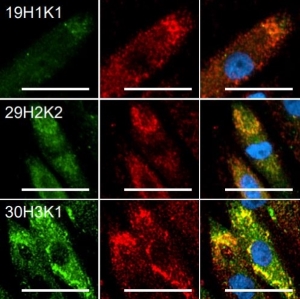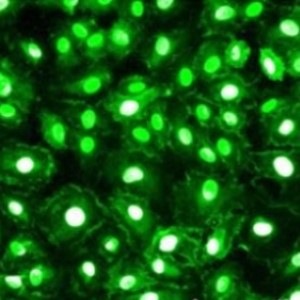Product Details
Product Sizes
| Size | List Price | Price | Cart |
|---|---|---|---|
| 100 ul | $329.00 | Add to Cart |
The Ki67 protein was first discovered when researchers attempted to generate cancer cell specific monoclonal antibodies by injecting mice with nuclear preparations from Hodgkin’s lymphoma cells. The presence of the Ki67 protein is frequently used as an indicator of cell proliferation and its level of expression is one of the most reliable biomarkers of proliferative status of cancer cells. Much research shows a correlation between Ki67 protein level and prognosis in cancer patients, when high Ki67 levels being associated with poorer outcomes. RA22150 was made against a recombinant construct including amino acids 1,111-1,490 of the human sequence P46013, a region corresponding to 2nd, 3rd and 4th Ki67 type repeats. Although Ki67 is relatively poorly conserved in amino acid sequence, this antibody recognizes both rat and mouse Ki67. Note that the Ki67 proteins are very unstable and only expressed in large amounts in situations where many cells are dividing. As a result of the very short half life of Ki67 there are usually numerous fragments visible on western blots running below the 395kDa and 345kDa bands. Product Highlights: |
Images
Immunofluorescent analysis of HeLa cells stained with rabbit pAb to Ki67, RA22150, dilution 1:5,000 in red, and mouse monoclonal antibody to fibrillarin in green. The blue is DAPI staining of nuclear DNA. The Ki67 protein accumulates in and around the nucleoli of interphase cells such as those on the right, and the nucleoli are revealed by the fibrillarin antibody. In contrast, cells in the quiescent G0 state such as those on the left are Ki67 negative but fibrillarin positive.
Western blot analysis of equal amounts of cell lysates using rabbit pAb to Ki67, RA22150, dilution 1:10,000, (green): [1] protein standard (red), [2] rapidly growing HeLa cell cultures, [3] rapidly growing HEK293 cell cultures. Strong double bands larger than the 250kDa standard correspond to full length 345kDa and 395kDa Ki67 isoforms, while smaller proteolytic fragments of these isoforms are also invariably detected on the blot.






